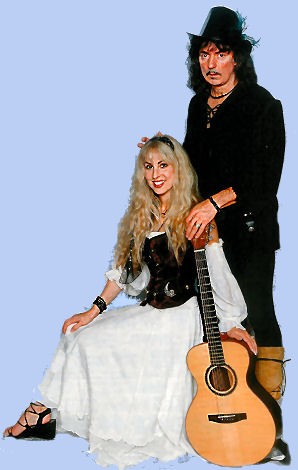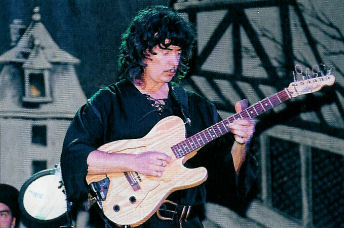|
Ritchie Blackmore IN THE COURT OF THE PURPLE KING  RITCHIE BLACKMORE, DARK LORD OF COLD-HEARTED RIFFAGE, IS STILL UP FOR HIS LATEST QUEST: BRINGING EARLY MUSIC TO TODAY'S LISTENERS. PETE LANGMAN BEGS AN AUDIENCE...
RITCHIE BLACKMORE, DARK LORD OF COLD-HEARTED RIFFAGE, IS STILL UP FOR HIS LATEST QUEST: BRINGING EARLY MUSIC TO TODAY'S LISTENERS. PETE LANGMAN BEGS AN AUDIENCE...Long considered one of the most influential rock guitarists that this wee island has ever produced, Ritchie Blackmore has been responsible for, among other things, the classic, fashion-transcending, default guitar riff: Smoke On The Water. It is, like marbles, part of the cultural capital of childhood: never taught, always played. Many thought Ritchie Blackmore's recent Renaissance 'direction' was a side project, a mere flash in the pan, and that once Deep Purple's musical differences were forgotten, he would go and storm arenas and stadiums once more. But Blackmore doesn't do side projects. 'I have trouble getting motivated if it's not something I believe in,' he declares. 'I'm kind of lazy on the side, too. I like to take a lot of time off.' So instead of strutting his stuff in front of millions of denim-clad fans, the new, more small-scale Blackmore is playing gigs in castles and stately homes, sometimes to as few as 150 people. With his partner, Candice Night, he's also changed his sartorial style to a more olde tyme garb: 'Sometimes I feel like I'm onstage in my underwear,' he allows. But it's no Tap-style joke: Blackmore's turnaround is deep and heartfelt. 'When I first started this music, having played to thousands and thousands of people, I wanted to go the old route,' Blackmore explains. 'I envied people who could sit down with a guitar and play to 10 or 12 people in a small room or a restaurant. I was impressed by that, because I knew that the band that I was in couldn't do that. It's a very different thing. if you're playing to 500 people it's very quiet, and they're listening to every nuance.' And it's not just the musician who has changed. 'A lot of the old fans have grown up,' he points out. 'They've sort of mellowed in their old age...' Of course, in his larger shows, Blackmore still breaks out his Strat, plugs it into his Engl (no more Marshall stacks) and plays a short set of more rock influenced material, but the rest of the tunes are more acoustic-based. For most of his songs wields a Lakewood, or a pair of exotic-looking Alvarez-Yairis, amplified as little as possible. 'I don't think they've yet come out with an amp which amplifies the acoustic to how it can sound in a room,' he says. 'One of these days someone will come up with one that just sounds like a big guitar.' He also plays a mandola, and a fabulously droning hurdy-gurdy: 'I think a lot of guitar players would play the hurdy-gurdy if they heard it properly, because it has a really roaring sound, almost like a heavy rock guitar,' he recommends. Blackmore doesn't do compromise, either. He has always played by ear and instinct, and in the past he's often assumed that others can do the same. 'When I first started this I thought it would be easy to get people to play the parts,' he admits, 'but there were a lot more subtleties than I had anticipated, and a lot of players found it hard. Again, I was getting through a lot of people. I refused to settle for second-best.' But it's this idiosyncratic, single-minded drive that makes Blackmore's projects so compelling. When the scourge of a thousand eardrums says 'when you start turning down the amps you start hearing everybody's musical inadequacies,' you have to sit up and take notice. Blackmore is renowned for The Riff, yet this project - and especially the balladic Beyond The Sunset, a new compilation of the more romantic songs from his past four studio albums - rely primarily on melodies, often culled from 16th century sources. I Still Remember was developed around a museum-grade tune by Tielman Susato, yet harmonically it's pure Blackmore, drawing the ear back to the classic Dio-era Rainbow tune Stargazer. Oddly enough, Blackmore swears that the only reason he originally played riffs was because, back in the '60s, that was what he identified as 'the way forward'. 'It's more natural for me to get an acoustic guitar and whistle or hum the melody to myself, and not have some big riff going on,' he now points out. When working from original melodies, he'll give the tune to his keyboard player, and take his own cues from the original counterpoint. Yet he's no early music purist. 'Sometimes I'll prefer what I've put in to what was written down,' he admits. This attitude to composition is reflected in Blackmore's approach to the mandola, which he plays fingerstyle instead of using a pick. 'I put heavier strings on it. It kills my fingers,' he says, matter-of-factly. 'I have to grow my nails and put acrylics on them. I don't know whether it's standard technique, because I've never seen it.' Blackmore seems to work on the principle that he has an instrument, and he needs to get a sound, so he manipulates it accordingly. 'I tune the mandola to whatever I want to,' he adds. 'I keep it in fourths most of the time, like to the guitar, and other times I tune it to octaves, so the top strings are an E, then an octave-down E on the third pair, the second pair would be a B, and the fourth would be an octave down on the B.'  Today Blackmore is a changed man, especially when it comes to live performance ('in the old days, it was just a question of going on stage and running around and acting kind of like monkeys'). Now he wants to connect with his audience rather than blow them away.
Today Blackmore is a changed man, especially when it comes to live performance ('in the old days, it was just a question of going on stage and running around and acting kind of like monkeys'). Now he wants to connect with his audience rather than blow them away.'With an electric it's so easy to hold a powerchord and impress people with slurring a note, but you have to work so much harder playing an acoustic guitar, especially when it's very quiet,' he points out. 'Onstage, I'm playing much quieter with the band, and to try and captivate the audience playing that quietly can be tricky sometimes. I have to really know what I'm doing... I can't just wing it. Indeed, the new music is still challenging, and some of the tunes - such as Minstrel Hall - don't simply float off the fingers. 'I'm always a little bit relieved once I've played that one, because that sets me up for the whole evening to be "on" or "off",' he admits. Now Blackmore is feeling like a kid again, and drooling over new guitars in shop windows. 'I think I've become a better player, because I tend to practise more. The guitar started to almost bore me about 20 years ago. I'd go onstage and play the heavy rock stuff, which I enjoyed... but I felt I wasn't getting any further.' Indeed, he listens to very little guitar music these days. 'I'm more taken by woodwind than guitar,' he says. 'Sometimes I'm impressed by a player like Joe Satriani, but I play it once and then I'm back playing other music.' He's particularly keen on the shawm, an early precursor to the oboe, and he collects them. 'I can't play a note on them, but they look so good on the shelf...' And what do his Purple buddies think? 'I think they think I'm pretty crazy. Jon Lord understands where I was going, but some of the others just thought I was just being awkward, a bad little doggie.' The 'bad little doggie' now wants to produce an album of more 'staunch' Renaissance music, like the tunes he plays live, such as Mr Peagram's Morris And Sword and Possum Goes To Prague, but he's still constantly searching for the right way forward. 'I'm always torn between doing it the basic, acoustic way... or do we modernise it, put more fairy dust on it?' Ritchie Blackmore thinks for a minute. 'It ends up with more fairy dust on it, most of the time...' Instruments: Fender Strat, MIDI-fitted Tele, Alvarez-Yairi, Taylor, Lakewood; mandola; hurdy-gurdy Amps: Engl 100W Blackmore stacks Who Rules: Renaissance composers, Django, Leo Kottke Album: Beyond The Sunset: The Romantic Collection is out now. © Pete Langman, Guitar & Bass - January 2005 Photos: © Action Press/Rex features (top), Nicky J. Simms/Redferns |